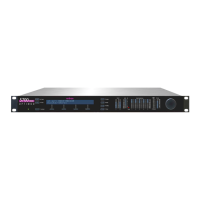OPTIMOD-FM DIGITAL INTRODUCTION
1-25
driven equipment will undo the effect of the 5700i’s internal de-emphasis, so the
5700i’s output level should be adjusted such that the tone produces 100% modula-
tion of the transmission link as measured after the link’s pre-emphasis filter. At
100Hz, switching the de-emphasis out or in will have negligible effect on the level
appearing at the 5700i’s left and right audio outputs.
You can adjust the frequency and modulation level of the built-in line-up tone. You
can use the front panel, the PC Control software, or the opto-isolated remote con-
trol interface ports to activate the Test Tone.
Built-in Calibrated Bypass Test Mode
A BYPASS Test Mode is available to transparently pass line-up tones generated ear-
lier in the system. It will also pass program material, with no gain reduction or pro-
tection against overmodulation. It can transparently pass any line-up tone applied
to its input up to about 130% output modulation, at which point clipping may oc-
cur.
Monitoring on Loudspeakers and Headphones
In live operations, highly processed audio often causes a problem with the DJ or
presenter’s headphones. The delay through the 5700i can be as much as 37 milli-
seconds (when S
OFT bass clipping is selected). This delay is likely to be audible as a
distinct echo, which most talent finds uncomfortable and distracting. However, the
normal delay through the 5700i (from input to FM outputs) is about 18 ms when
H
ARD or MEDIUM bass clipping is selected, as it is in all factory presets other than
those with “LL” (“low latency”) or “UL” (“ultra-low latency”) in their names. An 18
ms delay is workable for most talent (although it may require some acclimatization)
because they do not hear echoes of their own voices in their headphones. Conse-
quently, users can ordinarily replace an older processor with the 5700i with no stu-
dio wiring changes. Moreover, off-air cueing of remote talent is routine.
Two lower-delay options are available. “Low latency” reduces input / FM-output de-
lay to 13 ms and “ultra-low latency” reduces delay to about 3.7 ms. The trade-off for
this reduction is approximately 1 dB decrease in loudness compared to the 5700i’s
full look-ahead processing for low latency and about 2.5 dB loudness decrease for
ultra-low latency.
• You can invoke the low latency mode by setting the B
ASSCLIPMODE control (in
the C
LIPPERS page of ADVANCED CONTROL) to LLHARD, or by recalling a preset with
“LL” as part of its name.
LLHARD differs in two ways from the normal HARD mode of the bass clip-
per:
• LLHARD automatically defeats the compressor lookahead. (This action
is functionally equivalent to setting the L
OOKAHEAD control to OUT, ex-
cept that it reduces input/output delay by 5 ms).

